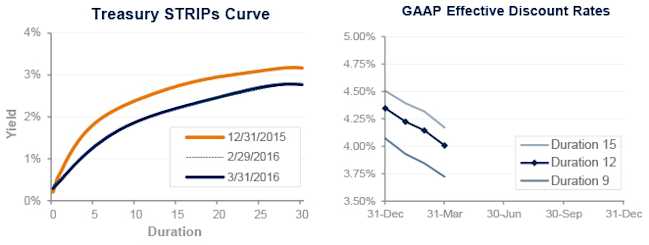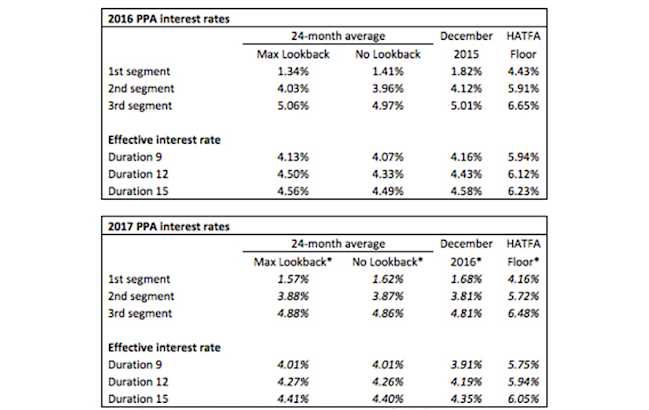March 2016 Pension Finance Update
Good month, bad quarter. Pension sponsors recovered some ground last month but remain in the red for 2016 at the end of the first quarter. Both model pension plans we track1 gained ground last month: Plan A improved 2% in March, but remains down more than 5% this year, while Plan B added 1% last month and is now down 3% during 2016:

Assets
During March, stocks regained most of the ground they had last earlier in the year: the S&P 500, NASDAQ, and overseas EAFE index all gained 7% during the month, and the small-cap Russell 2000 added 8%. At the end of the first quarter, the S&P 500 is up more than 1%, but the other indexes are all down around 2% so far in 2016.
A diversified stock portfolio gained 7% In March and is now down less than 1% through the first three months of 2016.
Treasury bonds were close to flat last month and interest rates were largely unchanged, but lower credit spreads reduced long-term corporate rates, producing returns of 1%-2% on these bonds. For the year, bonds are now 3%-5% ahead, with longer duration bonds doing best.
Overall, our traditional 60/40 portfolio gained almost 5% in March and is now up 1% for the year, while the conservative 20/80 portfolio gained 2% last month and is now up 3% during 2016.
Liabilities
Pension liabilities (for funding, accounting, and de-risking purposes) are now driven by market interest rates. The graph on the left compares Treasury STRIPs yields at December 31, 2015, and March 31, 2016, and also shows the movement in rates last month. The graph on the right shows our estimate of movements in effective GAAP discount rates for pension obligations of various duration during 2016:

Treasury yields were basically unchanged during March and remain down more than 0.40% this year. Meanwhile, corporate bond yields fell 0.10% last month, and are now down 0.35% in 2016, as credit spreads remain a bit wider than at the end of 2015.
The move pushed pension liabilities up 1%-2% last month; liabilities are now 6%-7% higher than at the end of 2015, with long duration plans seeing the biggest increases.
Summary
Through the first quarter of 2016, pension sponsors remain underwater. The stock market has moved sideways since the end of 2014, and long-term interest rates are again within striking distance of the all-time lows we saw in early 2015.
The graphs below show the movement of assets and liabilities for our two model plans this year:

Looking Ahead
The Obama Administration and Congressional leaders passed a budget last fall that includes a third round of pension funding relief since 2012. The upshot is that pension funding requirements over the next several years will not be appreciably affected by current low interest rates (unless these rates persist). Required contributions for the next few years will be lower and more stable than under prior law.
Discount rates moved down about 0.1% last month. We expect most pension sponsors will use effective discount rates in the 3.5%-4.2% range to measure pension liabilities right now.
The table below summarizes rates that plan sponsors are required to use for IRS funding purposes for 2016, along with estimates for 2017. Pre-relief, both 24-month averages and December ‘spot’ rates, which are still required for some calculations, such as PBGC premiums, are also included.

* October Three estimate, based on rates available as of 3/31/2016.
Did you find this article helpful? Want to stay up to date on current events and regulation changes within retirement? Sign up for our newsletter and never miss an update.
October Three Consulting, LLC is a full service actuarial, consulting and technology firm that is a leading force behind the reemergence of defined benefit plans across the country. A primary focus of the consultants at October Three is the design and administration of comprehensive retirement benefits to employees that minimize the financial risks and volatility concerns employers face.
Through effective plan design strategies October Three believes successful financial outcomes are achievable for employers and employees alike. A critical element of those strategies is the ReDB® plan design. The ReDefined Benefit Plan® represents an entirely new, design-based approach to retirement and to the management of both the employer’s and the employee’s financial risk, focusing on maximizing financial efficiency and employee value.
For more information:
233 South Wacker Drive, Suite 8350Chicago, IL 60606-7147info@octoberthree.comPhone: 312-878-2440Fax: 866-945-9676Contact Us
1 Plan A is a traditional plan (duration 12 at 5.5%) with a 60/40 asset allocation, while Plan B is a cash balance plan (duration 9 at 5.5%) with a 20/80 allocation with a greater emphasis on corporate and long-duration bonds. For both plans, we assume the plan is 100% funded at the beginning of the year and ignore benefit accruals, contributions, and benefit payments in order to isolate the financial performance of plan assets versus liabilities.
